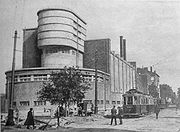
Red Banner Textile Factory
Encyclopedia


Leningrad
Leningrad is the former name of Saint Petersburg, Russia.Leningrad may also refer to:- Places :* Leningrad Oblast, a federal subject of Russia, around Saint Petersburg* Leningrad, Tajikistan, capital of Muminobod district in Khatlon Province...
(now St Petersburg), Pionerskaya ulitsa (Pioneers street), 53 was designed by Erich Mendelsohn
Erich Mendelsohn
Erich Mendelsohn was a Jewish German architect, known for his expressionist architecture in the 1920s, as well as for developing a dynamic functionalism in his projects for department stores and cinemas.-Early life:...
and later partly redesigned by S. O. Ovsyannikov, E. A. Tretyakov, and Hyppolit Pretreaus (the senior architect of the project). Built in 1926–1937.
Mendelsohn was the first foreign architect in 1925 to be asked to design in the USSR, on the basis of his dynamic, futuristic Expressionist architecture
Expressionist architecture
Expressionist architecture was an architectural movement that developed in Europe during the first decades of the 20th century in parallel with the expressionist visual and performing arts....
. A model was made of a large factory, similar though more functionalist
Functionalism (architecture)
Functionalism, in architecture, is the principle that architects should design a building based on the purpose of that building. This statement is less self-evident than it first appears, and is a matter of confusion and controversy within the profession, particularly in regard to modern...
in appearance to his earlier Luckenwalde hat factory. Mendelsohn made several trips to the USSR during its construction. He was inspired by the country's Constructivist architecture
Constructivist architecture
Constructivist architecture was a form of modern architecture that flourished in the Soviet Union in the 1920s and early 1930s. It combined advanced technology and engineering with an avowedly Communist social purpose. Although it was divided into several competing factions, the movement produced...
, and wrote a study entitled Russland-Europa-Amerika. However, the primitive construction techniques of the time were insufficient to realise the structure in full, and liberties were taken with Mendelsohn's design.
Mendelsohn participated only in the first stage of the project in 1925–1926. He drew an initial (later modified) plan of the factory and designed the power station of the factory, officially recognized as an object of Russian historical and cultural heritage (built in 1926). The other buildings were completed by S. O. Ovsyannikov, E. A. Tretyakov, and Hyppolit Pretreaus in 1926—1928 and 1934—1937. Now the entire complex of buildings of this factory is included in the List of newly revealed objects of historical and cultural heritage, issued by the government of Saint-Petersburg in 2001 (with additions of 2006).
Mendelsohn disowned the building after its completion in 1926, although he would frequently make use of the model as an example of his approach to industrial architecture. The factory is still partly in use as storage space.

